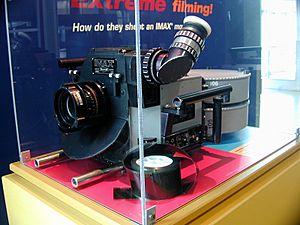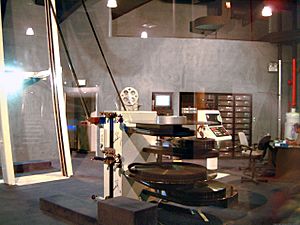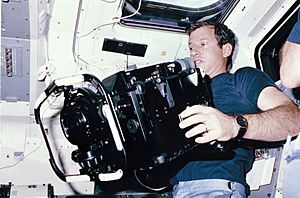IMAX facts for kids
IMAX is a special way to show movies that makes them look super big and clear! It uses a unique kind of film that's much larger than what regular movies use. This system was created in Canada in the late 1960s and early 1970s by a team of inventors.
IMAX movies have amazing picture quality and are much bigger than normal films. Unlike regular movie projectors, the film runs sideways. This makes the picture wider than the film itself. Since 2002, many popular movies have been changed to the IMAX format. Some movies even film parts of their scenes using special IMAX cameras! IMAX is very popular for showing movies in unique places. As of 2017, there were over 1,200 IMAX theaters in 75 countries.
Contents
The History of IMAX Movies
People have always wanted to make movies look more exciting. In the late 1960s, a group of Canadian filmmakers and inventors worked together. They wanted to create a movie system that used one big screen instead of many smaller ones. This new system was designed by William C. Shaw. It used a special "Rolling Loop" technology to move the film.
Once they realized that one huge screen was much more impressive, the company changed its name to IMAX. The very first IMAX movie was called Tiger Child. It was shown at a big event called Expo '70 in Osaka, Japan.
The first permanent IMAX theater opened in May 1971 in Toronto, Canada. It was at the Cinesphere theatre at Ontario Place. The first movie shown there was North of Superior.
At Expo '74 in Spokane, Washington, a giant IMAX screen was a major attraction. It was about 27 meters (89 feet) wide and 20 meters (66 feet) tall! This screen filled the viewer's entire vision. It made people feel like they were really moving, which was a cool and sometimes dizzying experience!
The first permanent IMAX Dome theater opened in San Diego in 1973. It also worked as a planetarium. The first permanent IMAX 3D theater opened in Vancouver for Expo '86.
In 2008, IMAX started making digital theaters. These were cheaper to build because they could change existing movie rooms into IMAX screens. This helped IMAX grow a lot. By 2015, there were over 1,000 IMAX screens around the world.
IMAX Theaters: A Unique Experience
IMAX theaters are built in two main ways. Some are "Classic Design," which means they are special buildings made just for IMAX. Others are "Multiplex Design," which are regular movie rooms that have been updated.
Classic IMAX theaters are very different from normal ones. Because the picture is so clear, you can sit much closer to the screen. All the seats are usually within one screen height away. In regular theaters, you sit much further back. Also, the seats in IMAX theaters are often steeply angled. This makes sure you are looking directly at the giant screen.
A typical IMAX screen is about 22 meters (72 feet) wide and 16.1 meters (53 feet) tall. But they can be even bigger! The largest IMAX screen today is in Melbourne, Australia. It measures 32 meters (105 feet) wide and 23 meters (75 feet) tall. Imagine how huge that is!
OMNIMAX: Movies All Around You!

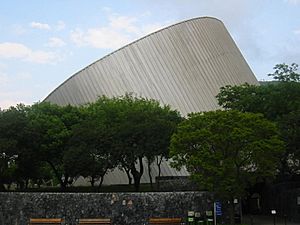
OMNIMAX is a special type of IMAX where the movie screen is a giant dome. The picture wraps around you, covering 180 degrees horizontally. It goes far above you and a little bit below you. This makes you feel like you are right inside the movie!
OMNIMAX first showed movies in 1973. IMAX later changed the name to IMAX Dome. However, some theaters still call it OMNIMAX. These dome theaters are often found in theme parks and science museums. They are great for showing educational films about space or nature. The projection room is often visible to the public. This lets people see the cool technology behind the movie.
The biggest IMAX Dome screens in North America are in Jersey City, New Jersey and Vancouver. Both of these dome screens are about 27 meters (89 feet) across!
Feature Films and IMAX Cameras
It's very hard to film an entire movie using only IMAX cameras. This is because the cameras are much bigger and heavier than regular ones. They also make more noise, which makes it tough to record dialogue. Plus, the film only lasts for about 30 seconds to two minutes before needing to be changed. The film itself is also much more expensive.
Even so, some big movies have used IMAX cameras for certain scenes. For example, The Dark Knight had six scenes filmed with IMAX cameras. This was the first time a major movie used IMAX cameras for parts of the film. After that, other directors like Michael Bay for Transformers: Revenge of the Fallen and Christopher Nolan for Interstellar also used IMAX for big scenes.
Even music videos have used IMAX cameras! Adele's "Hello" (2015) and Rihanna's "Sledgehammer" (2016) both used these special cameras for parts of their videos.
IMAX in Space
Did you know IMAX cameras have flown into space? NASA astronauts have used handheld IMAX cameras on 17 missions! They used them to record what it's like in space. An IMAX camera was even mounted in the cargo area of the Space Shuttle. Footage from these missions was used in the 1985 IMAX movie The Dream Is Alive.
The Kennedy Space Center in Florida has two IMAX 3D theaters. They show movies about space, including real footage shot by astronauts. Two of the IMAX cameras used by NASA are now on display at the National Air and Space Museum in Washington, D.C..
Awards for IMAX
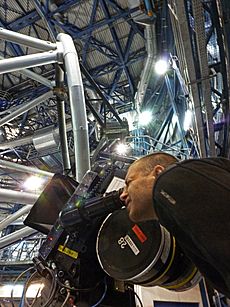
In 1996, IMAX won an Oscar for Scientific and Technical Achievement. This award was given by the Academy of Motion Picture Arts and Sciences. It recognized IMAX's amazing work in creating and improving how to film and show large, wide-angle movies.
Other Cool Uses for IMAX
Many IMAX films have been made into HDTV format. You can also find them on DVD and Blu-ray Disc. Some places, like the Science Museum London, have even used IMAX screens for video game tournaments! Imagine playing a game on a screen that huge!
IMAX film segments have also been used in fun amusement park rides. These include "Back to the Future: The Ride" and "Soarin' Around the World" at Disney parks.
Images for kids
-
Christopher Nolan is a big fan of the IMAX 70 mm film format.
See also
 In Spanish: IMAX para niños
In Spanish: IMAX para niños



